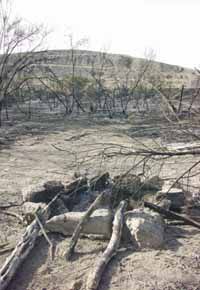| The stage one alert prohibits open burning activities in Carbon County and the southern half of the state. Local officials believe children playing with matches or other combustible materials may have caused several recent grass fires. |
Temperatures are climbing and conditions are getting drier, increasing an already high fire danger faced residents at locations across the state.
Due to the situation, the Utah Division of Forestry in conjunction with the United States Forest Service and U.S. Bureau of Land Management have issued a stage one fire alert for almost all of the southern and much of the eastern areas in the state.
“A stage one fire restriction order is not usually needed until late June or early July, so this is an indication of just how dry things are,” explained state forester Joel Frandsen. “Needless to say, we’re asking everyone to be especially careful with all forms of fire.”
The alert comes at the end of a record setting dry winter and spring. The fire alert will remain in effect until rescinded.
Locally, the alert covers all of Carbon and Emery counties, with the exception of national forest lands in the Manti-LaSal Range.
“I expect they will be joining the alert soon,” said Rudy Sandoval, the state fire warden for Carbon and Emery counties.
The restriction prohibits fireworks as well as open fires or campfires except in a developed recreation site.
Smoking is also prohibited except in an enclosed vehicle or building, a developed recreation site or an area cleared of all flammable materials.
The use of propane stoves is not prohibited.
In recent weeks, wildfires in southern California and Arizona have shown how dry the west is and how dangerous the blazes can be to animals, people and structures.
“People don’t think what is happening around Tucson could happen here – but it could,” said Sandoval.
Fireworks pose a major concern around the middle of the summer. But this time of year, fires are often caused by people burning trash or debris.
A number of recent blazes in the county have resulted from the burning of fields and ditches.
Officials believe one of the primary causes may have been children playing with fire or matches.
With the dry conditions and plenty of fuel available, the fires could turn into tragedies with a loss of life, major damage or both.
County residents can do a number of things to protect families from wildfires that could spread onto private properties.
Recommended pactices include:
•Create a safety zone or fire break around the structure.
The safety goal of landscaping and maintenance is simple – reduce the amount of fuel immediately surrounding structures.
However, it does not mean the landscape has to be barren. Some plants are more fire resistant than others.
One of the most important things rural residents can do is to create a safety zone or fire break around the house using resistant plants.
The zone can consist of numerous varieties, including grasses, border plantings, flowers and vegetables.
In most areas, a safety zone should be cleared around a home for a distance of not less than 30 feet.
As the slope of the lot increases, additional clearance as far out as 100 feet may be necessary.
Clearance also depends on vegetative conditions that provide ladder fuels that enable fire to climb into trees.
Trees and shrubs are fine, as long as dead or low-hanging branches are removed and the height of ground vegetation is controlled.
•Remove tree limbs around chimneys and dead branches that may hang over the roof.
Accumulated leaves, needles and other dead vegetation should also be removed.
•Beyond 100 feet from the house, dead wood and older trees should be removed or thinned.
Watch for limbs that may come in contact with power lines. Residents not equipped to trim the limbs should contact a local power company.
•Keep the roof clear.
Sweep the gutters, eaves and roof on a regular basis, especially during the hot weather of the fire season.
Tinder-dry needles and leaves are a fire waiting to happen.
•Refrain from stacking firewood under the porch or eaves.
Sparks from a grass fires can ignite the wood and quickly spread to the structure.
Stack firewood well away from anything combustible, including fences and outbuildings.
•Outdoor incinerators or burning barrels for household trash are prohibitted during the stage one alert.
•Install as many smoke detectors as local regulations require.
In addition, equip all buildings with fire extinguishers.
•Homes should have at least two ground level doors to use as safety exits in case of fire.
Each room should have at least two means of escape, including a door and a window leading to the outside.
This is especially true in bedrooms.
Wildfires can engulf homes quickly. The more exits the better.
As the summer wears on, the stages of fire alerts can change.
Based on past experience, the fire situation seldom gets better before the fall.
One thing Carbon County residents who may start a wildfire need to remember is that if the individuals are apprehended, they very well could be held financially responsible for the costs of putting out the blaze.
Even the smallest of wildland fires can cost thousands of dollars to extinguish.
People residing in the Carbon and Emery County area wishing to conduct controlled burns during the fire restriction season must obtain a permit.
Carbon and Emery residents may request controlled burn permits by contacting Rudy Sandoval at 650-0114.

